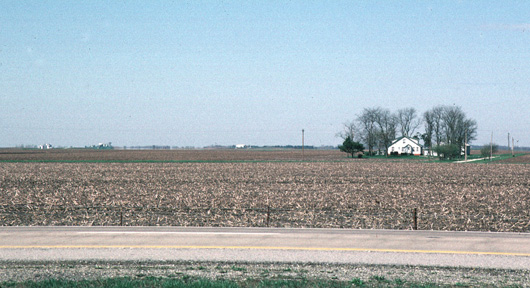GROUND MORAINES
Rolling-to-flat landscapes that form under the ice sheet are referred to as ground
moraine, or till plain. These landscapes form as the ice margin rapidly retreats, not
pausing long enough to form end moraines, but nonetheless
depositing till and other sediments haphazardly across the landscape. Much of Michigan's
prime farmland is located on ground moraines.
As the ice rapidly retreated by melting or evaporation from one moraine
to the next, it left its burden of mixed rock waste just where it melted, just as a
persistent winter snowdrift leaves an assortment of clay, sand, and sticks, when it melts
in the spring. If the ice carried much rock waste it left low hills; if the ice was fairly
clean, the drift left was thin. These plains are ground moraines
or till plains. Till plains are quite stony lands. In some
places the till plains at the present surface were deposited on the ground moraines of an
earlier ice advance, and their undulating topography may be due to the topography of the
land upon which they were deposited. Till plains are some of the best, most easily worked
farm lands in the State. On till plains small blocks of ice were buried for centuries and
left depressions (kettles) when they melted. Water remained in these and other depressions
in which vegetation grew and in time filled the depressions with an accumulation of plant
material, which accounts for the patches of dark soil (Histosols)
on our farm lands.
Much of southern Michigan is a landscape formed directly beneath the
ice sheet. These ground moraine landscapes tend to be flat to gently
rolling.

If the soils are loamy, as they are on much of the Saginaw Lobe
terrain, the flatness of the landscape allows for row agriculture. These landscapes
are Michigan's corn belt.
This material has been compiled for educational use only, and may not be reproduced without permission. One copy may be printed for personal use. Please contact Randall Schaetzl (soils@msu.edu) for more information or permissions.